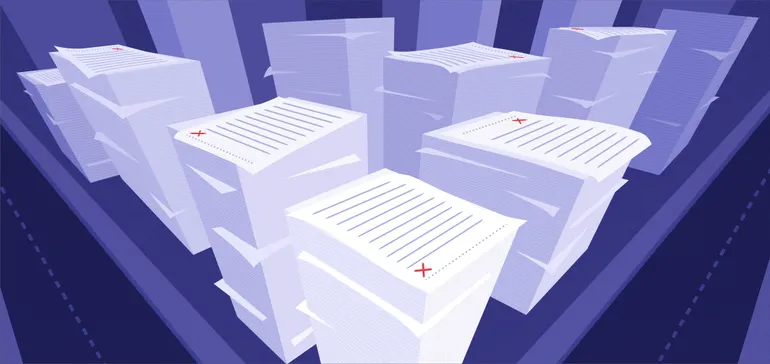This feature is a part of “The Dotted Line” series, which takes an in-depth look at the complex legal landscape of the construction industry. To view the entire series, click here.
From the outside, a data center structure looks like a simple warehouse. Its construction contract would reveal a different story.
Data center construction is booming in the U.S. Contractors on the ground report being buried in early-stage activity, even amid concerns of a slowdown.
For example, Apple unveiled plans earlier this summer to invest at least $20 billion on two data centers in Pennsylvania. Hyperscaler CoreWeave also recently selected a joint venture of New York City-based Turner Construction and Wohlsen Construction of Lancaster, Pennsylvania, to build its $6 billion facility.
For contractors looking to get in on the action, the math is simple. Win a data center award, collect a large check. Landing the right contract, though, is anything but simple.
“Data center projects tend to be relatively simple structures with really sophisticated power and utility needs and really unique equipment requirements,” said Andrew Greene, office managing partner in the Seattle office of law firm Perkins Coie. “From a risk management standpoint, it’s more dealing with supply chain issues, dealing with labor issues.”

Andrew Greene
Courtesy of Perkins Coie
Most data centers use engineering, procurement and construction contracts or turnkey models, where one contractor designs and builds the facility, said Trent Cotney, a partner and construction team leader in the Tampa, Florida, office of law firm Adams & Reese. That structure simplifies ownership but creates a heavier lift for the contractor.
“What makes it more complicated is the amount of regulation that goes into a lot of these contracts,” Cotney told Construction Dive. “There is adherence to fire codes, NFPA, NEC, permitting related issues, all those types of things.”
Fast track delivery
Developers are more eager than ever to capture artificial intelligence demand as quickly as possible. It’s made fast-track delivery on data center projects become the industry norm, said Cotney.
But speed also magnifies the risks.
The rush to build swiftly “puts a big burden on the contractor,” said Cotney. Greene noted many projects sit in remote locations, where sourcing enough specialized labor is already difficult. The combination means a greater potential for mistakes.
“We do a lot of OSHA defense for construction and general industry, and unfortunately, we’ve had some incidents on these types of projects,” Cotney told Construction Dive. “Anytime you’re dealing with high voltage, this level of fast track, it requires operational excellence. Navigating safety in this type of environment is absolutely critical.”
Materials in the spotlight
Copper ranks one of the most key inputs on these jobs, given its central role in power distribution and cabling. Recent tariffs on the material have caused a host of problems for contractors with data center projects.
“Copper is a pretty important element of a lot of the equipment that goes into these types of projects,” Greene told Construction Dive. The prices have fluctuated significantly in the last year, and it’s expected to continue over the next year and a half, he said.
“That price fluctuation tends to impact projects indirectly, through the availability and cost of the equipment that gets installed,” said Greene.
Cotney highlighted tariff-related increases won’t show up in the data immediately. Instead, these impacts work their way through the supply chain over four to 12 months, depending on how quickly inventory turns over and whether distributors absorb some of the added expense.

Trent Cotney
Courtesy of Adams and Reese LLP
That delay makes it harder for contractors to predict cost impacts.
To protect themselves, Cotney said many firms insert price acceleration provisions that allow for contract adjustments if a material rises more than 5%, or they may use tariff-specific clauses tied to U.S. Customs data. Others pursue strategies such as pre-purchasing, or negotiating direct purchase orders where the owner buys the material outright.
“The end result is where you’re basically going to the end user, the owner or developer, and saying here is the tariff hit. Here is the direct impact of that. Here’s a change order reflected on that,” Cotney told Construction Dive. “And you have a contractual basis to do that.”
Attorneys also flagged other sensitive inputs. Equipment sourced internationally, such as transformers or generators, often dominates the risk profile, said Greene, since availability and shipping schedules drive the entire project timeline.
Cotney added aluminum, fiber optics, lithium batteries and refrigerants can all complicate negotiations as well. Cooling systems, in particular, pose unique challenges.
“There have been a variety of EPA regulations in the past that truncated what cooling systems can be used,” Cotney told Construction Dive. “There’s a large agenda on this administration as far as rolling back some stuff, but to my knowledge, some of those still are up in the air. So, being able to obtain the refrigerants needed to power these giant cooling systems within these data centers is something that’s unique.”
He added that emerging technologies in this area, such as liquid cooling, could further shift how contracts address these risks in the years ahead.
“I think there’s going to be some major evolution of how we go about cooling these things to make it more efficient,” said Cotney. “But for now, refrigerant is a concern.”
Workforce and cybersecurity
Labor is another pain point in contract talks.
Data center construction projects require many skilled electricians and mechanical workers, many of whom may hold temporary immigration status. That creates compliance challenges for owners and developers, who may require certified payrolls even when not federally mandated, said Cotney.
“A lot of the workforce that I see being used on these data center projects are under H-2B or temporary protective status, depending on what’s being done,” he said. “Immigration and workforce is obviously a big topic for all of construction right now.”
Security adds yet another layer. With these hyperscale facilities underpinning AI and cloud systems, guarding design and construction documents is more important than ever.
“What are we doing to protect information that is going to be conveyed on this construction because access to how this thing was built could, if it falls in the wrong hands, potentially be a huge cyber threat,” said Cotney. “So, confidentiality, cybersecurity protection, even as it relates to the contract and the contract documents, is critical because of the amount of information.”
Follow the money
Despite the risks, the construction industry agrees data center construction is a lucrative business in 2025.
“This is where the money is at right now. There is a lot of money being put out both by government and private industry to move this forward light speed,” Cotney told Construction Dive. “So, ton of profit, but also a lot of risk and I think you need to assess it in your contract.”
View the original article and our Inspiration here


Leave a Reply